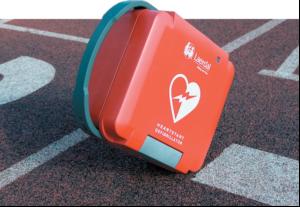David Brown discusses the pivotal role defibrillators
play in today's workplace and society
Circulatory disease is still a major
cause of death in the UK with the
British Heart Foundation
reporting that 124,000 heartDavid Brown discusses the pivotal role defibrillators
play in today's workplace and society
Circulatory disease is still a major
cause of death in the UK with the
British Heart Foundation
reporting that 124,000 heart attacks
happen in the UK every year. Fortunately
the number of new cases of heart attacks
has decreased over the past three decades,
partly due to people making changes to
their lifestyles, nevertheless they still
happen. When this statistic is combined
with the dismal survival rate of Sudden
Cardiac Arrest (SCA) victims, between five
and seven per cent, it is clear what a vital
role a defibrillator can play in reducing
these deaths.
A defibrillator, also known as an
Automated External Defibrillator (AED), is
a life-saving machine that gives the heart an
electric shock in cases of cardiac arrest. The
British Heart Foundation states that for
every minute that passes without
defibrillation chances of survival decrease
by an astonishing 14 per cent2. Research
shows that applying a controlled shock
within five minutes of collapse provides the
best possible chance of survival.
Adrian Waller, public safety manager at
Zoll Medical, states: "SCA occurs when the
electrical system of the heart stops working
effectively—the heart unexpectedly stops
pumping, when this happens, blood stops
flowing to the heart, brain and other vital
organs and within seconds, the victim
collapses and becomes completely
unresponsive. Death will occur if not
treated within the first few minutes."
He continues: "SCA is not the same as a
heart attack (acute myocardial infarction or
AMI). A heart attack is caused by a blockage
in an artery that supplies blood to the heart.
The affected heart muscle then begins to die
due to lack of oxygen. Symptoms include
central crushing chest pain, often radiating
to arms and jaw. The patient, however
usually remains awake and alert. A heart
attack can degenerate into ventricular
fibrillation when the victim becomes totally
unresponsive. The Resuscitation Guidelines
2010 state that the optimum treatment for
sudden cardiac arrest or ventricular
fibrillation is immediate good quality CPR
(Cardio Pulmonary Resuscitation) and
electrical "defibrillation" delivered by using
an AED."
The importance of AEDs
Michaela Parker, national defibrillation
manager at Laerdal Medical UK,
comments: "SCA can strike anyone, at
any age, at any time anywhere - often
without prior warning. Victims may
include work colleagues, business
associates, visitors, family and friends.
"Time to first shock is the most
important factor in deciding the outcome
of SCA. Over the years, Laerdal has
contributed to the spread of AEDs to
locations were they could be quickly and
efficiently used in case of SCA. 10 to 15
years ago the focus was to equip
emergency ambulances with AEDs and
today the majority of emergency
ambulances carry defibrillators. An even
wider spread of simpler to use AEDs has
demonstrated a positive impact on
survival with new technology enabling
those who are closer to the patient to
respond with a life saving shock within
the first 2 to 3 critical minutes - the time
when survival is so much more likely.
"Today's modern AEDs are designed for
use by anyone, at any time and in any
location. They are so simple to operate that
a first aider with minimal training can
potentially save the life
of a co-worker, friend or member of the
family or public."
So what would the likely scenario be if
suddenly someone at your workplace
collapsed due to SCA and was
unresponsive?
Adrian comments: "Some AED
manufacturers would have you believe
that a defibrillatory shock is the only
essential treatment when it comes to SCA.
Just place the electrode pads, deliver a
shock and the victim will sit up and thank
you for saving his life. If only it were so
simple.
"Many think defibrillation actually
"restarts" the heart, not so; the fibrillating
heart requires the "shock" to "stun" the
heart, briefly stopping the heart's chaotic
electrical activity that led to ventricular
fibrillation and SCA. Once defibrillated,
or stunned, if the heart is still viable,
normal electrical activity may resume
typically after a significant period of time
when good quality CPR has been
performed contributing to a successful
outcome."
Adrian adds: "The provision of AEDs
in the work place and wider community
has been rapidly increasing over the last
few years and it is estimated that there are
over 10,000 deployed across the UK. The
technology used in AEDs has made them
easy to use with a minimal amount of
training. The real issue is however
whether or not the AED will advise shock
at the time when you are going to use it
and equally as important are you able to
deliver the high quality CPR required for
a prolonged period of time."
Whilst anyone can use an AED, it's
preferable that people receive the
appropriate training first; if more people
were trained in CPR, it would buy time
before defibrillation."
As individuals continue to work long
hours and in many instances in places
where thousands of people are working
under one roof, the need for such life
saving equipment in the workplace
remains pivotal to help prevent needless
loss of life.
David Brown is the show organiser of The
Emergency Services Show.


